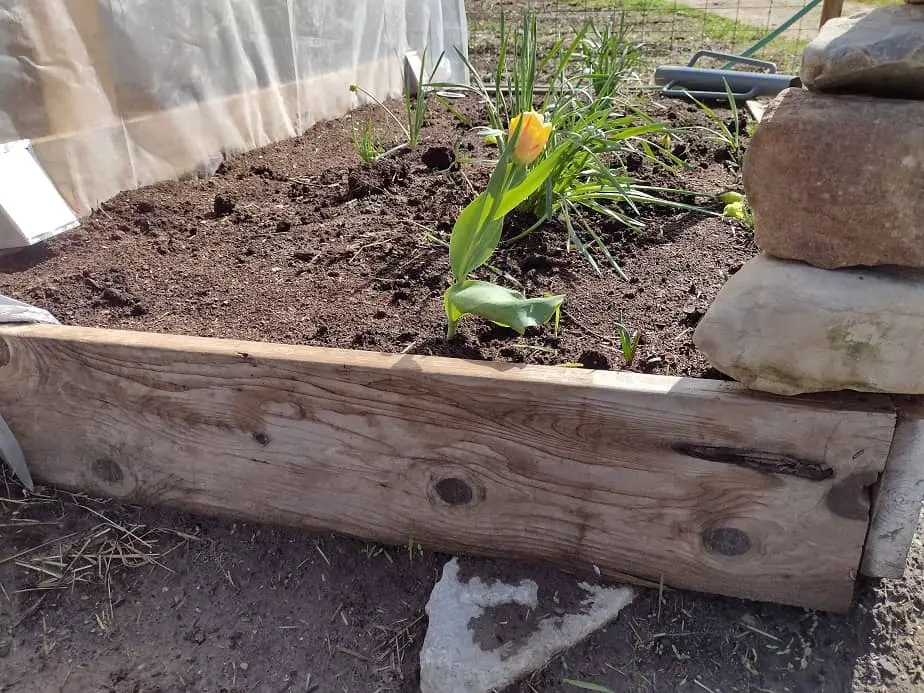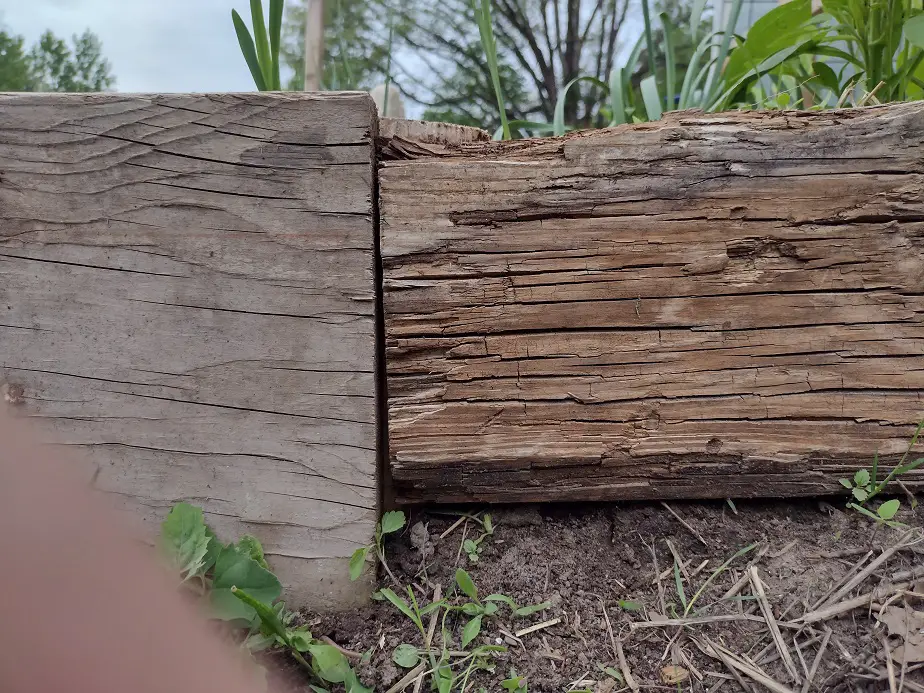Raised beds are darn popular, but need to be done right. too deep and you’re wasting good garden soil, but too shallow and your plants may get unhappy with you.
Raised garden beds should be at least one-foot deep if there is a barrier beneath them, or at least 6 inches if directly on the ground. Plant roots need space to dig for water and nutrients, and soil biology needs depth to establish natural layers of healthy soil life. Healthy beds can be several feet deep.
There’s a lot to that answer. Some plants need deeper roots. Soil, weather, and drainage can necessitate deeper or shallower beds. And, soil biology, which I’ve been studying a lot lately, is the most important factor.
How to Choose the Right Depth for a Raised Bed Garden
A good raised bed is up to a few feet deep. Most garden plants try to send roots at least three feet down and will be stunted if they hit a barrier or a layer of hard soil beneath a raised bed. 2-3 feet is often an ideal depth for raised beds to keep happy, healthy plants and soil.
The big question I have for you is, What are your goals for a particular raised bed? Do you want it dedicated to one particular plant, or will it be ever-changing? Are you trying to create a weed-free environment? Are you trying to work around bad soil?
I do highly suggest making a good-general use raised bed. That usually means a deeper one. Some plants, like strawberries, sunflowers, and a lot of herbs, are perfectly happy with shallow roots. But, cabbage, tomato, and onion, for example, would prefer to have roots extending 2-3 feet deep.
If you think you might rotate different things through your raised bed, I definitely recommend a deeper one. Now, I know that means more work and probably a higher cost to fill it up. I’ll cover some tips for that in a few minutes.
If all you’re trying to do is have a better drained or more fertile garden, you can definitely do fine with 8-inches or so. But, only if there’s no barrier underneath. the moment you lay down a weed barrier, gravel, or cinder blocks, you just made a deep bed a requirement. Those roots need room to grow.
I mentioned soil biology in the beginning. Soil biology is the majority of what happens in the garden and good soil biology makes gardens flourish. A lot of raised beds need have no concern about soil biology. But, if your subsoil is problematic or you want a barrier under the bed, you need to think about it.
When making good compost, we give 3 feet as the minimum depth for things to work well. the same applies to regular soil. That depth gives the soil the ability to develop natural layers of structure and biology. Proper layers of natural biology make plants’ roots happy.
Think of it like this. You have the bugs that crawl on top of the dirt. then there are beetles that crawl through the top half-inch of soil. Below that, we have various other insects including worms, grubs, and different bug larvae that all claim their own specific depth table as optimal for life.
The same thing happens on the microscopic level. BIllions of bacteria, amoebas, fungus, and algae all seek optimal conditions in the soil. If you pile up three feet of dirt, given a relatively short amount of time, all these natural layers will begin to develop.
All these different biological creatures work to create a small, singular piece of healthy soil. put them together in sufficient quantities and you have really good, naturally fertile, healthy living soil. That can’t happen in a 6-inch raised bed on concrete. Even weed barrier fabric will stunt things.
I’ll say it again, if you want a shallow bed, don’t put a barrier under it and if you really want a barrier, make it deep. That goes against the “traditional knowledge”. Most people will recommend a barrier under a shallow bed to keep weeds out.
The subsoil is full of weed seeds waiting for germination conditions. This is referred to as the “seed bank”. in a shallow bed, hoeing and tilling can bring weed seeds from the subsoil up into the soil of your bed. yes, but I have a fix for that. Don’t till it too deep.

How to Cheaply Fill a Raised Bed
Deeper raised beds can be partially filled with brush, tree trimmings, logs, and old firewood as a base. Leaves, lawn clippings, and bales of straw can also be used. Cheap garden soil or native soil, mixed with homemade compost and organic matter can help cheaply fill a raised bed.
For deeper (2-3 foot) beds, I like to fill at least the lower 1/3 with woody material like woodchips, old untreated boards, and branches that fall in the woods. I have used bales of hay and straw and that worked well. If you plan to use bales with plastic string, remove the string after setting them in place.
I like to fill gaps in the woody layer with whatever organic matter u can find, be that leaves, grass, banana peels; whatever is at hand. Then, I like to use my native soil and mix a lot of compost or partially composted materials in it. I like a 25 percent compost to soil ratio.
No-Till is Perfect for Raised Beds
I talked about natural soil layers and how it’s essential to good soil. Tilling, turning, and even hoeing soil destroys the shallower layers of soil structure. Then, the biological life is stunted and has to wait again for the natural layers to develop before they can flourish.
The method of avoiding tillage is called No-Till. In big gardens and fields, it’s incredibly hard to pull off. But in a raised bed, it’s super easy. Basically, you just leave the soil alone and let it do its thing. And let me tell you, it does make healthier living soil.
I’ve tested and tried it over the past few years. No-Till builds up the soil faster than anything I’ve ever tried. I have No-Till and tilled plots side by side, and the No-Till noticeably outperforms the competition.
There’s this old idea that soil needs to be tilled and fluffed before planting. Hogwash! Tilling the soil has a net negative impact. It causes loss of organic matter, and causes further loss of fertilizer. If your dirt is actually too hard to plant in, that’s a problem that tilling isn’t going to fix.
Tiling used to be said to bring up more fertile dirt from below, but that’s not the way soil works. Concentrate on building healthy living soil and you will find the key to fertility, fluffy dirt, and good drainage. Tilling is only useful as a way to break up leftover plant matter and kill weeds.
Fortunately, in a raised bed, you can just use a rake and hoe, or just your hands. Disturb the soil as little as you can get away with. It’s not lazy gardening, it’s smart gardening and working with the complex machine of nature’s soil system. Work with nature, because it doesn’t go well working against it.
Tips to Fertilize Raised Beds
The five primary nutrients plants need, in order of magnitude, are nitrogen, potassium, phosphorus, magnesium, and calcium. Of those, nitrogen, potassium, and magnesium are the fastest to deplete from the soil. They are the most water-soluble and move easily in the soil.
Phosphorus is the opposite. Its molecules have a strong magnetic pull that locks them in the soil. Phosphorus tends to build up in the soil to a point where it begins binding up the other necessary minerals as well. Too much phosphorus will make fertile soil unusable.
The problem is, that a lot of traditional fertilizers have too much phosphorus. An even fertilizer, like 13-13-13, has too much phosphorus for most uses. It used to be thought of as a “good enough” general use fertilizer, but now we know better. For most plants, a ratio more like 10-5-7 would be appropriate.
The middle number is the phosphorus content. Except for trees and shrubs, plants need more nitrogen and potassium than phosphorus. I don’t use much chemical fertilizer, but I often recommend a mix like Miracle Grow, the original one. It’s got a much better ratio of nutrients for plants.
Myself, I use mainly a mixture of fresh and composted manure and leaf mold. I’m not 100 percent organic, but I to lean that way. My garden has had about 1 ton of composted manure this spring. I will add probably 2 or 3 tons later in the season.
Organic matter is the cornerstone of a good garden. While organic material and compost aren’t quite fertilizer, it makes fertilizer work. The organic matter is able to feed soil microbes, which in turn convert the potential energy in the carbon-rich organic matter and humic acids into, fertilizer.
Organic matter also stores the minerals plants need, like a fertilizer savings account. Build up the soil organic content like a retirement account. Once there’s enough there, you can sit back and take those annual distributions.
Soil without much organic content is like retiring without savings. there’s just not going to be enough to cover basic needs. Instead of struggling to keep up fertilizing year to year, work at building up soil organic content, while adding fertilizer. High-organic soil needs a lot less fertilizer than low-organic soil.
Test your soil with a soil test kit. I like the Luster Leaf 1602 soil test kit. You can find it on Amazon. in a 10×10 raised bed, I’d start with half a pound of Miracle Grow as a base. If the soil test shows nutrients in the middle range, I’d do about half of that.
Test your soil before planting, twice during the growing season, and again after the harvest. That way, you can learn how your soil behaves and just how much nutrition your plants are wanting.
Related Articles:

